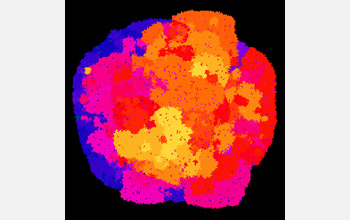Multimedia Gallery
Researchers study the evolution of altruism with evolutionary processes inside a computer.
Researchers study the evolution of altruism with evolutionary processes inside a computer. Here, digital organisms in Avida self-replicate and fill empty spaces (black). Mutations can occur during reproduction, which often creates organisms with different fitness levels (represented by different colors). Over many generations, those mutations that happen to create more fit organisms tend to be selected for, as in naturally evolving populations.
Credit: Kaben Nanlohy, Michigan State University
Images credited to the National Science Foundation, a federal agency, are in the public domain. The images were created by employees of the United States Government as part of their official duties or prepared by contractors as "works for hire" for NSF. You may freely use NSF-credited images and, at your discretion, credit NSF with a "Courtesy: National Science Foundation" notation.
Additional information about general usage can be found in Conditions.
Also Available:
Download the high-resolution JPG version of the image. (1.4 MB)
Use your mouse to right-click (Mac users may need to Ctrl-click) the link above and choose the option that will save the file or target to your computer.
Related story: Digital Organisms Shed Light on Mystery of Altruism

